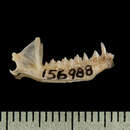en
names in breadcrumbs


Perception Channels: tactile ; chemical
Other Physical Features: endothermic ; bilateral symmetry
Key Reproductive Features: gonochoric/gonochoristic/dioecious (sexes separate); sexual
Emballonuridae is a family of microbats, many of which are referred to as sac-winged or sheath-tailed bats. They are widely distributed in tropical and subtropical regions around the world. The earliest fossil records are from the Eocene.[1][2]
The emballonurids include some of the smallest of all bats, and range from 3.5 to 10 cm in body length. They are generally brown or grey, although the species of genus Diclidurus are white. The faces are said to be handsome, the heads being comparable to those of domestic dogs, and their wings are long and narrow. As with other microchiropteran families, they use ultrasonic echolocation to sense the surrounding environment and their prey; the signals of some species are unusual in being audible to humans.[3]
Possession of the postorbital processes, the reduced, noncontacting premaxillaries, and rather simple shoulder and elbow joints, which is similar to pteropodids, makes them rather a primitive group. However, they are more advanced in the reduction of the second digit phalanges and the flexion of the third digit proximal phalanges over the metacarpal dorsal side.[2]
The wing surface extends between the legs, a membrane known as a uropatagium, and the structure of these is a characteristic in many of the genera. They have tails which are partially enclosed, a short part of which projects through the uropatagium to form a sheath. The usual arrangement of the uropatagium is as to be fixed to the tail, but the sheathtail feature is joined by an elastic component which allows greater flexibility; they are able to use the hind legs for locomotion and to adjust the membrane's surface while in flight.[4] As a common name indicates, many species also possess sac-shaped glands in their wings (propatagium), which are open to the air and may release pheromones to attract mates. Other species have throat glands which produce strong-smelling secretions.[5] They have the dental formula
These bats generally prefer to roost in better-illuminated areas than other species of bats. Their dwellings can often be found in hollow trees and entryways to caves or other structures. Some species, such as the genus Taphozous, live in large colonies, but others are solitary. Species living away from the tropics may enter periods of torpor or extended hibernation during colder months.[5]
Emballonurids feed mainly on insects and occasionally on fruit. Most of these bats catch their meals while flying.
The common name for some groups, 'sheath-tailed bats', is sometimes noted as sheathtails.[3]
Found in the Neotropics, Afrotropics, southern Asia, Australia and South Pacific islands.[2]
Family Emballonuridae
Emballonuridae is a family of microbats, many of which are referred to as sac-winged or sheath-tailed bats. They are widely distributed in tropical and subtropical regions around the world. The earliest fossil records are from the Eocene.